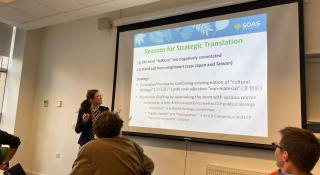
Breadcrumbs navigation
Trump opens the door for a deadlier arms race, and the danger of 'limited' nuclear war
His decision to walk away from the Open Skies Treaty is part of a pattern aimed at converting the bipolar era arms control regime into one which could unrestrain the US and hold China down.
US President Donald Trump’s decision to withdraw from the vital if obscure Open Skies Treaty (OST) represents a tangible and symbolic step towards the deconstruction of the international arms control regime between the major nuclear powers, an escalation of a new arms race, and the continued attempt to bind and freeze Chinese military power.
It is also another material gift to the largest arms manufacturing firms which have benefitted enormously from Trump’s destabilising rhetoric and actions undermining peace and security in numerous world regions. Finally, it is an ideological-electoral move to further assuage his far right and paleo-conservative ideological cronies, and his loyal America First voter bank.
Thus far, the Trump administration has withdrawn the United States from several significant international institutions and agreements that were the hallmark of its post-1945 global strategy. While other postwar administrations withdrew wholly or partially from such organisations, or sometimes refused to join when US sovereignty was considered at stake, no previous administration has philosophically and methodically challenged the very idea of the international.
Under Trump, there has been a veritable bonfire of global alphabet agencies: One of his earliest acts upon taking office in January 2017 was to disown the Trans-Pacific Partnership. Since then, the US has withdrawn from the Paris climate accord, the UN Human Rights Council (UNHRC), UNESCO, the INF treaty, and the JCPOA. Most recently, of course, the US has accused the World Health Organisation (WHO) of China-centrism, promptly defunded it during the worst global pandemic since 1918 and has just announced the US withdrawal from the global body. The message could hardly be more starkly conveyed.
In addition, we might note US threats to other international bodies unless their members comply with demands for greater resourcing or funding. NATO is a prime example. The World Trade Organisation is also in the administration’s cross-hairs.
And the violation of international law – on asylum seekers, refugees, and the assassination of foreign leaders, for example – indicates the other front on which the US is acting unilaterally in a systematic fashion.
None of the above is new in and of itself, of course. What is new is the systematic, concentrated, and determined character of the zero-sum thinking at the heart of the Trump administration. This suggests a basic philosophical shift – not to withdrawal from world affairs, not towards ‘isolationism’. – but in mentality towards the ‘global’.
President Trump is a national Darwinist. In world politics, he represents a survival-of-the-fittest mentality, a reverence for power as the arbiter of disagreements. Hence, US power is being systematically weaponised – the dollar, the international payments system, the “whole-of-society threat” and ‘response’ to China, the US market, trade tariffs to incentivise greater investment inside the US, the threat of withdrawal from international treaties when others exercise independence. And US military predominance is adding a ‘space force’ to its plans, to add to its cyber and other forces.
Another international regime unravelling
In the mid-1950s, Moscow rejected President Eisenhower’s proposal to allow aerial reconnaissance flights over each other’s territory. Towards the end of the Cold War, President George H.W. Bush pushed for negotiations on the proposal between NATO and Warsaw Pact countries. After painstaking negotiations, the Open Skies Treaty entered into force on January 1, 2002, with 34 states party to the treaty.
The OST aimed to establish a regime of unarmed observation flights over the territories of state parties to assure they are not preparing for hostile military action. It was a confidence-building measure that worked.
Yet, some say Trump apparently grew uneasy with the OST when a Russian aircraft flew directly over his golf club in Bedminster, New Jersey, in 2017. With due notice of 72 hours, the plane was legally permitted to fly through the restricted airspace under the treaty.
As ever, Trump’s idiosyncratic behaviour is encased within a strategic logic – record levels of US military spending including on new nuclear missile systems and forces can now no longer be observed by Russia. And allegations of Russian violations of the OST – that Russia excludes over-flights in Ossettia, South Abkhazia, and the enclave of Kaliningrad, for strategic reasons – though correct, have been tolerated for over a decade. They could have formed the basis of discussions between the signatory powers.
Since 2002, the US has undertaken three times as many over-flights of Russia than vice versa. In 2019, for example, the US made 18 such flights compared to seven by Russia. Given the sophistication of US satellite technologies, however, it has clearly decided that such over-flights are either unnecessary or that the OST regime needs to be broken and replaced with a comprehensive global treaty that also includes China.
This is another move that undermines, if not dismantles, the existing nuclear arms-control regime, breaking the confidence-building mechanisms that reduced the threat of nuclear exchange. This may well lead to greater misunderstanding between Russia and the US. This happened at the height of the Cold War in 1960, for example, when the erstwhile Soviet Union shot down an American U-2 spy plane on a reconnaissance mission over its territory.
However, the OST move is also ‘red meat’ to Trump’s far right ideological allies, the GOP leadership, and to his political base. In an election year, “Trump-stands-up-to-Russia” and moves to pressure China takes the heat out of the impeachment decision and allegations that he’s been ‘soft’ on Russia, too cosy with Putin, and with Xi Jinping.
Nuclear agreements melting down, an eye on China?
In May 2018, Trump withdrew from the Iran nuclear agreement (JCPOA), despite Iran’s compliance with its protocols and conditions, including the most intrusive inspection regime administered by the International Atomic Energy Agency (IAEA). Again, the other major signatories, including Germany, France, China, and Russia, objected to US withdrawal but to no avail.
In August last year, the Trump administration completed the process of withdrawal from the 1987 Intermediate-Range Nuclear Forces (INF) Treaty, leaving the nuclear arms control regime in the lurch. One aim is to extend the agreement to include China’s cruise missiles.
It is now pretty clear that President Trump will seek an exit from the 2010 New Strategic Arms Reduction Treaty (New START), the only remaining agreement to ensure that the United States and Russia limit their deployed nuclear missiles to 1,550 each. This pact is due to expire in February 2021. It could hardly be clearer that the aim is to seek a new trilateral pact that includes China. The basic idea is to bring Beijing’s nuclear arsenal under control and to curtail any desires to attain nuclear parity with Washington. But Beijing is not interested; its nuclear arsenal (numbering in the hundreds) is tiny in comparison with the US and Russia (numbering in the thousands).
But such a move would be in line with the longer-term strategic aim of simultaneously containing, engaging and now, rolling back, China’s great power capabilities and ambitions, real, imagined, or potential, to knock the US from its sole superpower position.
The idea of a winnable nuclear war remains
But there is one other factor that should be borne in mind. The idea of a winnable nuclear war – however horrific it may sound – has never been fully excised from US strategic thinking. Ever since the dropping of two atomic bombs over Japan in 1945, and the ever-present talk of using tactical or low yield nuclear bombs over North Korea in 1950-53, the very idea of containable, limited nuclear war remains embedded. A so-called low yield nuclear bomb is the equivalent of the size that annihilated Hiroshima and Nagasaki.
The US has around 1000 low yield bombs in its stockpile – about 150 of them deployed in Europe. President Trump has indicated a desire to attach low yield nuclear warheads to submarine-launched ballistic missiles, thus multiplying America’s nuclear arsenal.
While such weapons have been available for decades, they have never been used.
Having low or high yield nuclear weapons is either a reflection of ‘mad man theory’ – a rational irrationality – or it’s for real: and that’s the point. It keeps everyone guessing. As Charles Kupperman, Trump’s former deputy national security adviser, argues: “a nuclear war is winnable in the classical sense if one side emerged the stronger, even if there were tens of millions of casualties.”
American paleo-conservatives want to integrate the nuclear with non-nuclear military options to legitimise the use of strategic nuclear weapons in a “limited” way. Donald Trump’s Nuclear Posture Review (NPR) released in early 2018, brought low-yield nuclear weapons back into the nuclear debate. It stated that the US was not averse to resorting to the use of nuclear arms in response to “significant non-nuclear strategic attacks,” against it. The NPR approved the production of a low-yield nuclear warhead, increasing nuclear tensions. Trump favours an aggressive nuclear policy and is willing to rock the boat moored to mutually-assured destruction (MAD).
More recently, it is rumoured that the US is considering conducting nuclear tests again for the first time in decades. Administration sources suggest, without evidence, that Russia and China are already conducting low yield nuclear tests, to justify their possible shift of position. It is also suggested that the threat of new nuclear testing, which would violate the de facto compliance by all nuclear powers (except North Korea) of the Comprehensive Nuclear-Test-Ban Treaty of 1996, would give the US leverage to force Russia and China to trilateral talks to hash out a new agreement.
For Trump, the moves are driven by personal preference – he gets more headlines; a geopolitical great game; material gain to arms firm donors to his re-election campaign; a sop to the Republican leadership; encouragement to his far right nationalist unilateralists; and gives his voters something to shout about. And he can call Joe Biden “soft on China” – “Beijing Biden”.
It’s win-win politics, for him. The only problem is that the fate of the world then rests on unilateral American decision-making.
Author
Inderjeet Parmar is a former Chair of BISA, currently professor of international politics at City, University of London, a visiting professor at LSE IDEAS (the LSE’s foreign policy think tank), and visiting fellow at the Rothermere American Institute at the University of Oxford.
Dr Atul Bhardwaj is an honorary research fellow in the department of international politics at City, University of London. He is the author of India-America Relations (1942-62): Rooted in the Liberal International Order (Routledge, 2018)
Photo by Library of Congress on Unsplash


